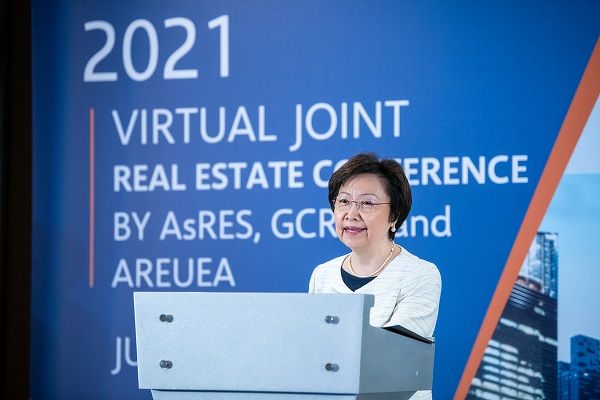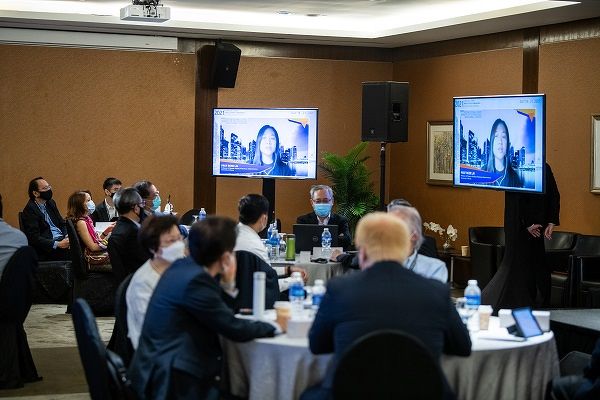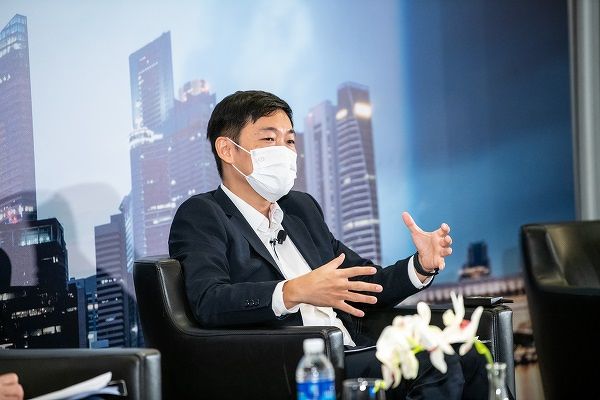No need to overhaul cities for post-Covid world, say urban design experts
By Timothy Tay
/ EdgeProp Singapore |
(From left) Liu Thai Ker, chairman of Morrow Architects & Planners; Cheong Koon Hean, chair of the Lee Kuan Yew Centre for Innovative Cities; Cheng Hsing Yao, CEO of GuocoLand Group; and panel moderator Seek Ngee Huat. (Picture: NUS Department of Real Estate/ NUS IREUS)
SINGAPORE (EDGEPROP) - While the Covid-19 pandemic has highlighted existing city planning challenges, urban builders should not use the disruptions caused by this pandemic to overhaul the way cities are planned and designed, says Liu Thai Ker, chairman of Morrow Architects & Planners. (See also: Investing in strata offices in a post-pandemic world)
“Let us not be too hasty to say that because of the impact of the Covid-19 pandemic, (urban planners) should change the nature of cities or change the way we plan a city. Covid-19 is just a tiny part in the whole structure of city planning,” says Liu.
Advertisement
He also expresses concerns about the potential over-reliance on smart technology in city design. Using an analogy of a body to describe urban planning and design, he says: “If you design a city like a cripple, no amount of smart technology will turn it into a smart city. But if you plan the city as a healthy body, smart technology becomes the vitamin to enhance the whole body.”
The veteran architect and former master planner of the URA gave these comments during an in-person panel discussion at the 2021 Joint International Real Estate Conference on July 19.

Liu shared his extensive experience in urban design, particularly the housing challenges faced during Singapore's early independence years. (Picture: NUS Department of Real Estate/ NUS IREUS)
The panel discussion was based on the theme “Planning for resilient and sustainable cities after Covid-19” and moderated by Seek Ngee Huat, chairman of Institute of Real Estate and Urban Studies (IREUS) of the National University of Singapore (NUS).
The conference was jointly organised by the NUS Department of Real Estate, NUS IREUS, along with the Asian Real Estate Society (AsRES), Global Chinese Real Estate Congress (GCREC), and the American Real Estate & Urban Economics Association (AREUEA). EdgeProp Singapore was the official media partner for the event.
Building sustainable and resilient cities
The other industry experts on the panel were Cheong Koon Hean, chair of the Lee Kuan Yew Centre for Innovative Cities at the Singapore University of Technology and Design, and chairman of the Centre for Liveable Cities, a division of the Ministry of National Development; Professor Lam Khee Poh, dean of the School of Design and Environment at NUS (who tuned in virtually from the US); and Cheng Hsing Yao, CEO of GuocoLand Group.
Cheong gave the keynote speech at the start of the event, reiterating the importance of building resilient and sustainable cities, especially after the experience of living through the Covid-19 pandemic. “It is no longer enough to only focus on building sustainable cities; we need to ensure that cities are resilient as well,” she says.
Advertisement

During her keynote speech, Cheing emphasised the importance of building both sustainable and resilient cities. (Picture: NUS Department of Real Estate/ NUS IREUS)
She adds that developing green buildings is not enough to ensure that cities and built environments become more resilient and liveable places for the future. Urban planners and developers should not only focus on sustainability aspects during urban planning, but also consider urban design that ensures built environments are resilient to social, environmental, and economic challenges, says Cheong.
Future city planners may also have to consider setting aside more plots for flexible uses. Cheong says that even as we continue to develop the urban areas, we should not be too deterministic in zoning land use. “We would have to move from a more blueprint-like approach to flexible scenarios to plan for uncertainties.
This means that we may have to set aside tracts of land where the land use is not predetermined,” she says. This concept is not new and was reflected as reserve land sites in development master plans during Singapore’s colonial past. Today, flexible land zoning is seen in the white sites set aside by the government.
It is also timely to reconsider building design and making real estate assets more multi-functional. “During this pandemic it has become more common to see the conversion of existing spaces into quarantine facilities or health facilities with a relatively quick turnaround time,” says Cheong.

Due to travel restrictions, the international conference had a mix of physical and virtual presentations; pictured on the screen is Professor Rosie Lai, executive director of the Asian Real Estate Society. (Picture: NUS Department of Real Estate/ NUS IREUS)
While she was CEO of HDB from 2010 to 2020, she encountered similar types of conversion initiatives, but it was not easy to pull off at the time. “We have to make assets more multi-functional, and the design of future buildings needs to be more flexible with wide spans and open spaces that can be quickly reconfigured,” she adds.
Designing flexible spaces
These sentiments were echoed by another panellist, Cheng of GuocoLand. The private property developer is behind landmark mixed-use developments in Singapore such as Guoco Tower in Tanjong Pagar in the CBD, as well as the upcoming Guoco Midtown in Bugis.
Advertisement
According to Cheng, the pandemic experience around the world over the past year or so has shown that the cities which have been more resilient are those built with close collaboration between the public sector and private enterprises.
He says that Singapore’s experience in quickly converting hotels into quarantine centres and rolling out private testing centres to serve the community is based on the pre-existing strong relationship between private sector landlords and public institutions.
Going forward, the largest use group that would experience significant change in a post-pandemic environment would be the office sector given the large-scale adoption of remote working, says Cheng. “From our experience managing our premium office spaces in Guoco Tower, despite the push towards work-from-home arrangements, we have been able to maintain a very high occupancy rate of close to 100% for the office building,” he says.

Cheng is CEO of GuocoLand Group, a private developer behind land mark integrated developments such as Guoco Tower in Tanjong Pagar, and the upcoming Guoco Midtown in Bugis. (Picture: NUS Department of Real Estate/ NUS IREUS)
While some tenants were more exposed to the economic downturn and this resulted in contractions in the take-up rate, the landlord also welcomed new lease sign-ups. Cheng says that some new leases were signed during the “circuit breaker” in 2020 and the developer continues to see enquiries for its office spaces.
“Going forward, the office will remain relevant, but its role will change from a space where people report to for work, to a space that facilitates collaboration and socialisation, as well as the building of corporate culture and nurturing of mentorship relationships,” says Cheng.
Building cities to last
Taking a step back and looking at urban planning and design as a whole, Liu reiterated that while the pandemic has thrown a spotlight on city density and flexible space uses, architects and urban planners should also be cautious not to include too much flexibility in design plans.
“As a planner, we must try to implement long-term city plans with minimal changes to the basic urban systems as much as possible. Flexibility can come about through the modification of some urban designs,” says Liu.
He says that the introduction of white sites by the URA to cater for future unseen urban needs was a good concept. “But planners [should not] use flexibility as an excuse not to try to plan a city for its permanency. Cities are built of concrete and steel and if we keep demolishing them, we continue to contribute to global warming, which is a situation we do not want to see,” he adds.
https://www.edgeprop.sg/property-news/no-need-overhaul-cities-post-covid-world-say-urban-design-experts


Follow Us
Follow our channels to receive property news updates 24/7 round the clock.
Subscribe to our newsletter
Advertisement
Advertisement
Advertisement
Search Articles
